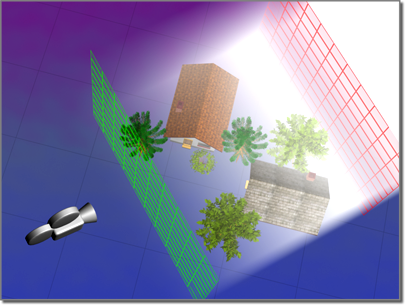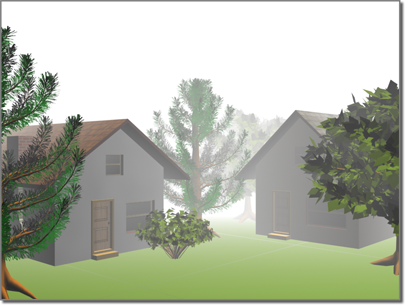Most of the camera controls are common to both kinds of legacy cameras. Free or Target.

- Lens
- Sets the camera's focal length in millimeters. Use the Lens spinner to give the focal length a value other than the preset "stock" values on the buttons in the Stock Lenses group box.
Changing the Aperture Width value on the Render Setup dialog also changes the value in the Lens spinner field. This doesn't change the view through the camera, but it does change the relationship between the Lens value and the FOV value, as well as the aspect ratio of the camera's cone.
- FOV Direction flyout
- Lets you choose how to apply the field of view (FOV) value:
-
 Horizontal (The default.) Applies the FOV horizontally. This is the standard way to set and measure the FOV.
Horizontal (The default.) Applies the FOV horizontally. This is the standard way to set and measure the FOV.
-
 Vertical Applies the FOV vertically.
Vertical Applies the FOV vertically.
-
 Diagonal Applies the FOV diagonally, from one corner of the viewport to the other.
Diagonal Applies the FOV diagonally, from one corner of the viewport to the other.
-
- FOV
- Determines how wide an area the camera views (field of view). When FOV Direction is horizontal (the default), the FOV parameter directly sets the arc of the camera's horizon, measured in degrees. You can also set the FOV Direction to measure FOV vertically or diagonally.
You can also adjust the field of view interactively in a camera viewport by using the FOV button.
- Orthographic Projection
- When on, the camera view looks just like a User view. When off, the camera view is the standard perspective-like view. While Orthographic Projection is in effect, the viewport navigation buttons behave as they ordinarily do, except for Perspective. Perspective function still moves the camera and changes the FOV, but the Orthographic Projection cancels the two out, so you don't see any change until you turn off Orthographic Projection.
Stock Lenses group
- 15mm, 20mm, 24mm, 28mm, 35mm, 50mm, 85mm, 135mm, 200mm
- These preset values set the camera's focal length in millimeters.
- Type
- Changes the camera's type from a Target camera to a Free camera, and vice versa.
Note: When you switch from a target camera to a free camera, any animation applied to the camera's target is lost, because the target object goes away.
- Show Cone
- Displays the cone (actually a pyramid) defined by a camera's field of view. The cone appears in the other viewports but does not appear in a camera viewport.
- Show Horizon
- Displays the horizon line. A dark gray line appears at the level of the horizon in the camera's viewport.
Environment Ranges group
- Near Range and Far Range
- Set the near and far range limits for the atmospheric effects set on the Environment panel. Objects between the two limits fade between the Far % and Near % values.
- Show
- When on, displays rectangles within the camera's cone to show the Near and Far range settings.


Top: Conceptual image of the Near and Far ranges.
Bottom: Result after rendering.
Clipping Planes group
Sets options to define clipping planes. In viewports, clipping planes are displayed as red rectangles (with diagonals) within the camera's cone.
- Clip Manually
- Turn on to define clipping planes.
When Clip Manually is off, geometry closer to the camera than 3 units is not displayed. To override this, use Clip Manually.
- Near Clip and Far Clip
- Sets near and far planes. Objects closer than the near clipping plane or farther than the far clipping plane are invisible to the camera. The limit of the Far Clip value is 10 to the power of 32.
With manual clipping on, the near clipping plane can be as close to the camera as 0.1 unit.
Warning: Extremely large Far Clip values can produce floating-point error, which can cause Z-buffer problems in the viewport, such as objects appearing in front of other objects when they shouldn't.
Conceptual image of Near and Far clipping planes.
Multi-Pass Effect group
These controls let you assign a depth-of-field or motion blur effect to the camera. When generated by a camera, these effects generate blurring by rendering the scene in multiple passes, with offsets. They increase rendering time.
- Enable
- When on, previewing or rendering uses the effect. When off, the effect is not rendered.
- Preview
- Click to preview the effect in an active camera viewport. This button has no effect if the active viewport is not a camera view.
- [effect drop-down list]
- Lets you choose which multi-pass effect to generate, Depth Of Field or Motion Blur. These effects are mutually exclusive. Default=Depth Of Field.
While Nitrous viewports are active, Camera viewports also display depth of field when Enable is turned on.
Note: The rollout for the chosen effect appears, by default, after the Parameters rollout. - Render Effects Per Pass
- When on, applies rendering effects, if any are assigned, to each pass of the multi-pass effect (depth of field or motion blur). When off, applies rendering effects only after the passes that generate the multi-pass effect. Default=off.
Turning off Render Effects Per Pass can improve the render time for multi-pass effects.
Target Distance setting
- Target Distance
- For a Free camera, sets a point to use as an invisible target so that you can orbit a camera around that point. For a Target camera, sets the distance between the camera and its target object.